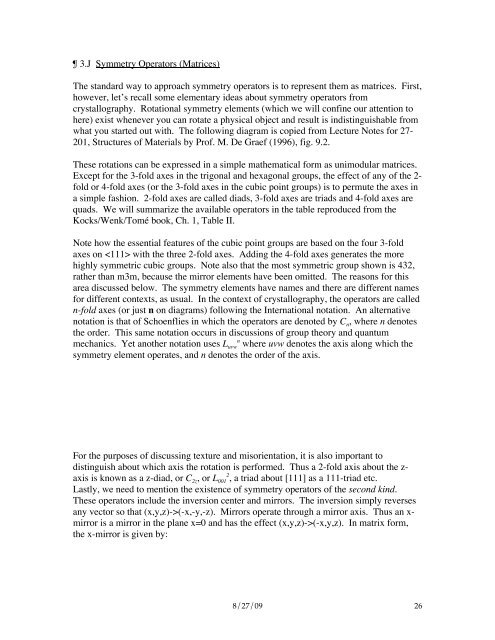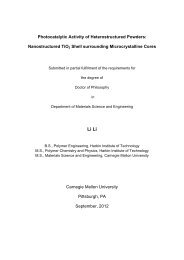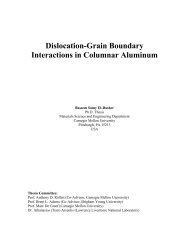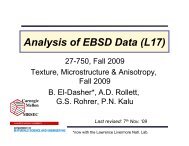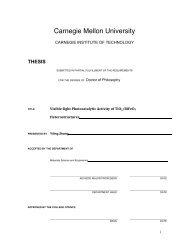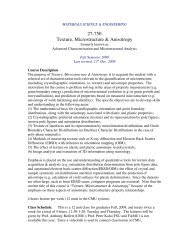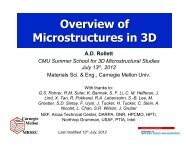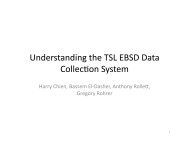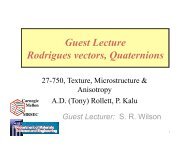¶ 3. Mathematical Representation of Crystal Orientation, Misorientation
¶ 3. Mathematical Representation of Crystal Orientation, Misorientation
¶ 3. Mathematical Representation of Crystal Orientation, Misorientation
Create successful ePaper yourself
Turn your PDF publications into a flip-book with our unique Google optimized e-Paper software.
<strong>3.</strong>J Symmetry Operators (Matrices)<br />
The standard way to approach symmetry operators is to represent them as matrices. First,<br />
however, let’s recall some elementary ideas about symmetry operators from<br />
crystallography. Rotational symmetry elements (which we will confine our attention to<br />
here) exist whenever you can rotate a physical object and result is indistinguishable from<br />
what you started out with. The following diagram is copied from Lecture Notes for 27-<br />
201, Structures <strong>of</strong> Materials by Pr<strong>of</strong>. M. De Graef (1996), fig. 9.2.<br />
These rotations can be expressed in a simple mathematical form as unimodular matrices.<br />
Except for the 3-fold axes in the trigonal and hexagonal groups, the effect <strong>of</strong> any <strong>of</strong> the 2fold<br />
or 4-fold axes (or the 3-fold axes in the cubic point groups) is to permute the axes in<br />
a simple fashion. 2-fold axes are called diads, 3-fold axes are triads and 4-fold axes are<br />
quads. We will summarize the available operators in the table reproduced from the<br />
Kocks/Wenk/Tomé book, Ch. 1, Table II.<br />
Note how the essential features <strong>of</strong> the cubic point groups are based on the four 3-fold<br />
axes on with the three 2-fold axes. Adding the 4-fold axes generates the more<br />
highly symmetric cubic groups. Note also that the most symmetric group shown is 432,<br />
rather than m3m, because the mirror elements have been omitted. The reasons for this<br />
area discussed below. The symmetry elements have names and there are different names<br />
for different contexts, as usual. In the context <strong>of</strong> crystallography, the operators are called<br />
n-fold axes (or just n on diagrams) following the International notation. An alternative<br />
notation is that <strong>of</strong> Schoenflies in which the operators are denoted by Cn, where n denotes<br />
the order. This same notation occurs in discussions <strong>of</strong> group theory and quantum<br />
n<br />
mechanics. Yet another notation uses Luvw where uvw denotes the axis along which the<br />
symmetry element operates, and n denotes the order <strong>of</strong> the axis.<br />
For the purposes <strong>of</strong> discussing texture and misorientation, it is also important to<br />
distinguish about which axis the rotation is performed. Thus a 2-fold axis about the z-<br />
2<br />
axis is known as a z-diad, or C2z, or L001 , a triad about [111] as a 111-triad etc.<br />
Lastly, we need to mention the existence <strong>of</strong> symmetry operators <strong>of</strong> the second kind.<br />
These operators include the inversion center and mirrors. The inversion simply reverses<br />
any vector so that (x,y,z)->(-x,-y,-z). Mirrors operate through a mirror axis. Thus an xmirror<br />
is a mirror in the plane x=0 and has the effect (x,y,z)->(-x,y,z). In matrix form,<br />
the x-mirror is given by:<br />
8/27/09 26


